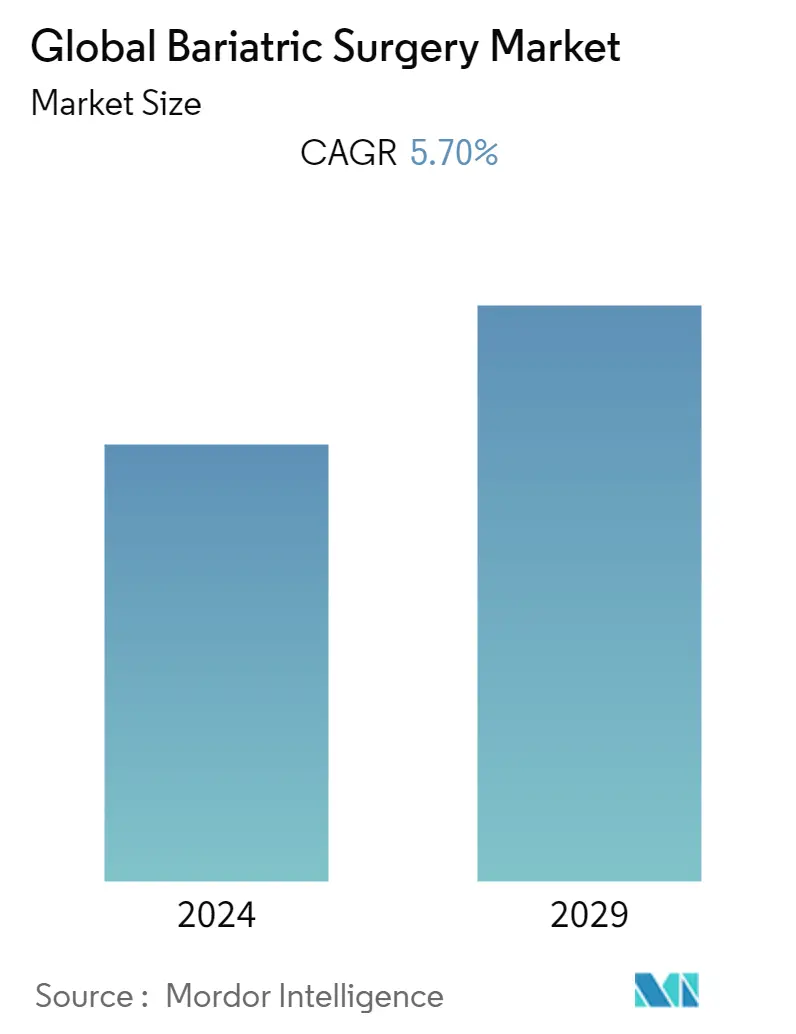Market Size of Global Bariatric Surgery Industry

| Study Period | 2019 - 2029 |
| Base Year For Estimation | 2023 |
| CAGR | 5.70 % |
| Fastest Growing Market | Asia Pacific |
| Largest Market | North America |
| Market Concentration | Medium |
Major Players
*Disclaimer: Major Players sorted in no particular order |
Bariatric Surgery Market Analysis
The Bariatric Surgery Market is poised to grow at a CAGR of 5.7% during the forecast period, 2022-2027.
On the market, the COVID-19 pandemic is anticipated to have a significant effect. The diagnostic and surgical industries have been impacted by the global lockdown measures, which have also decreased public mobility. As per the American Society for Metabolic & Bariatric Surgery (ASMBS), bariatric surgeries are considered non-emergent procedures, as a result, these procedures were on hold and their success rate has declined. As per a recent study 'Bariatric Surgery During the COVID-19 Pandemic the Perspective of Physicians and Patients', in September 2020, virtual consultation and telemedicine were considered suitable to continue weight loss programs, as the risks and complications of morbid obesity and surgery during the COVID-19 pandemic were high. The obese population is vulnerable to psychological and physiological conditions, which have hurt the pandemic's management of obesity. According to the Lancet article 'Bariatric and metabolic surgery during and after the COVID-19 pandemic' 2020, the pandemic has had a significant impact on obesity treatment, putting millions of children, adolescents, and adults at risk for worsening comorbidities, limiting their access to care and raising their chances of having poor COVID-19 outcomes. Thus, a large number of COVID-19 positive patients and its significant effect on healthcare systems across the world are responsible for the decline in several bariatric procedures and thereby negatively impacted the market in 2020 and slightly in 2021.
The major factors attributing to the growth of the bariatric surgery market are an increase in obesity among people and a rising prevalence rate of Type 2 diabetes and heart diseases. People with more fat in their bodies are highly likely to be affected by diabetes. Hence, patients are taking certain measures to prevent obesity with bariatric surgeries. For instance, according to the World Health Organization (WHO) May 2022 report on the European region, in the WHO European Region, over 60% of adults and 29% of boys and 27% of girls who are children are overweight or obese and also, as per the same report, overweight and obesity rank fourth among the risk factors for non-communicable diseases in the region, after high blood pressure, unhealthy eating, and cigarette use. Further, according to the December 2021 report of the International Diabetes Federation, it is estimated that about 537 million adults in the age group of 20-79 years were living with diabetes in 2021 across the world and this number is projected to increase to 643 million by 2030. Hence, owing to the high burden of obesity and the increasing prevalence of risk factors for obesity are expected to fuel growth in the bariatric surgery market over the forecast period.
Additionally, the rising prevalence of obesity increases the demand for bariatric surgery, which helps the market expand. According to the World Health Organization in June 2021, there were 39 million under-five years old kids who were overweight or obese 2020. In addition, it was estimated that 38.2 million kids under the age of 5 were overweight or obese in 2019. Overweight and obesity, once thought to be a problem only in high-income nations are now becoming more prevalent in low- and middle-income nations as well, especially in urban areas. Since 2000, there has been a nearly 24% increase in the proportion of under-five overweight children in Africa. Moreover, World Obesity Atlas March 2022 published by the World Obesity Federation, predicts that by 2030, one billion people worldwide, including one in five women and one in seven men, will have obesity. As a result, the market for bariatric surgery is anticipated to grow over the projection period due to the rising prevalence of obesity and the increased need for the procedure.
Furthermore, the market expansion is supported by a variety of strategies employed by the major market players, such as funding for research and development to broaden the scope of bariatric surgery. For Instance, In June 2021, Cincinnati-based Standard Bariatrics, Inc., developed the Titan SGS, a first-of-its-kind design that offers surgeons to perform sleeve gastrectomy, the top bariatric surgical procedure for obesity disease. Additionally in June 2021, to expedite the development and commercialization of their first bariatric surgical platform for sleeve gastroplasty, Standard Bariatrics has secured USD 35 million in Series B funding.
Therefore, it is clear that the growing prevalence of diabetes and obesity will significantly drive the market for bariatric surgery over the upcoming years. However, the high cost of surgery may restrain the market growth.
Bariatric Surgery Industry Segmentation
Bariatric surgery or weight loss surgery is used as one of the major treatment procedures for treating obesity. It is generally the last option for patients who have failed to lose weight by several other means. During this procedure, the size of the stomach is reduced by either removing some parts of the stomach or by using a gastric band. The Bariatric Surgery Market is segmented by Device (Assisting Devices, Implantable Devices, and Other Devices) and Geography (North America, Europe, Asia-Pacific, Middle East and Africa, and South America). The market report also covers the estimated market sizes and trends for 17 different countries across major regions, globally. The report offers the value (in USD million) for the above segments.
| By Device | |||||||
| |||||||
| |||||||
| Other Devices |
| Geography | ||||||||
| ||||||||
| ||||||||
| ||||||||
| ||||||||
|
Global Bariatric Surgery Market Size Summary
The bariatric surgery market is experiencing a steady growth trajectory, driven by the increasing prevalence of obesity and related comorbidities such as Type 2 diabetes and heart diseases. The market's expansion is supported by advancements in surgical techniques and technologies, as well as the growing awareness of the benefits of bariatric procedures. Despite the challenges posed by the COVID-19 pandemic, which temporarily halted non-emergent surgeries and impacted patient access to care, the market is rebounding as healthcare systems adapt and innovate. The introduction of new products, such as the Titan SGS surgical stapler and various gastric balloons, is further propelling market growth. These innovations are complemented by strategic funding and research initiatives aimed at enhancing the efficacy and accessibility of bariatric surgery.
North America is anticipated to maintain its dominance in the bariatric surgery market, largely due to the high obesity rates and robust healthcare infrastructure in the region, particularly in the United States. The presence of major market players and ongoing product launches are expected to bolster market growth. However, the high cost of surgery remains a potential barrier to market expansion. The competitive landscape is characterized by a mix of established players and emerging companies, with key players like Medtronic PLC, Ethicon Inc., and Apollo Endosurgery Inc. leading the market. As the demand for bariatric surgery continues to rise, driven by the increasing burden of obesity and diabetes, the market is poised for significant growth over the forecast period.
Global Bariatric Surgery Market Size - Table of Contents
-
1. MARKET DYNAMICS
-
1.1 Market Overview
-
1.2 Market Drivers
-
1.2.1 Increase in Obesity Patients
-
1.2.2 Prevalence Rate of Type 2 Diabetes and Heart Diseases
-
1.2.3 Government Initiatives to Curb Obesity
-
-
1.3 Market Restraints
-
1.3.1 High Cost of Surgery
-
1.3.2 Lack of Knowledge and Awareness in Developing and Underdeveloped Countries
-
-
1.4 Porter's Five Forces Analysis
-
1.4.1 Threat of New Entrants
-
1.4.2 Bargaining Power of Buyers/Consumers
-
1.4.3 Bargaining Power of Suppliers
-
1.4.4 Threat of Substitute Products
-
1.4.5 Intensity of Competitive Rivalry
-
-
-
2. MARKET SEGMENTATION (Market Size by Value - USD million)
-
2.1 By Device
-
2.1.1 Assisting Devices
-
2.1.1.1 Suturing Device
-
2.1.1.2 Closure Device
-
2.1.1.3 Stapling Device
-
2.1.1.4 Trocars
-
2.1.1.5 Other Assisting Devices
-
-
2.1.2 Implantable Devices
-
2.1.2.1 Gastric Bands
-
2.1.2.2 Electrical Stimulation Devices
-
2.1.2.3 Gastric Balloons
-
2.1.2.4 Gastric Emptying
-
-
2.1.3 Other Devices
-
-
2.2 Geography
-
2.2.1 North America
-
2.2.1.1 United States
-
2.2.1.2 Canada
-
2.2.1.3 Mexico
-
-
2.2.2 Europe
-
2.2.2.1 Germany
-
2.2.2.2 United Kingdom
-
2.2.2.3 Spain
-
2.2.2.4 Italy
-
2.2.2.5 France
-
2.2.2.6 Rest of Europe
-
-
2.2.3 Asia-Pacific
-
2.2.3.1 China
-
2.2.3.2 Japan
-
2.2.3.3 India
-
2.2.3.4 Australia
-
2.2.3.5 South Korea
-
2.2.3.6 Rest of Asia-Pacific
-
-
2.2.4 Middle East and Africa
-
2.2.4.1 GCC
-
2.2.4.2 South Africa
-
2.2.4.3 Rest of Middle East and Africa
-
-
2.2.5 South America
-
2.2.5.1 Brazil
-
2.2.5.2 Argentina
-
2.2.5.3 Rest of South America
-
-
-
Global Bariatric Surgery Market Size FAQs
What is the current Global Bariatric Surgery Market size?
The Global Bariatric Surgery Market is projected to register a CAGR of 5.70% during the forecast period (2024-2029)
Who are the key players in Global Bariatric Surgery Market?
Medtronic PLC, Ethicon Inc. (Johnson and Johnson), Apollo Endosurgery Inc., Intuitive Surgical Inc. and Olympus Corporation are the major companies operating in the Global Bariatric Surgery Market.

